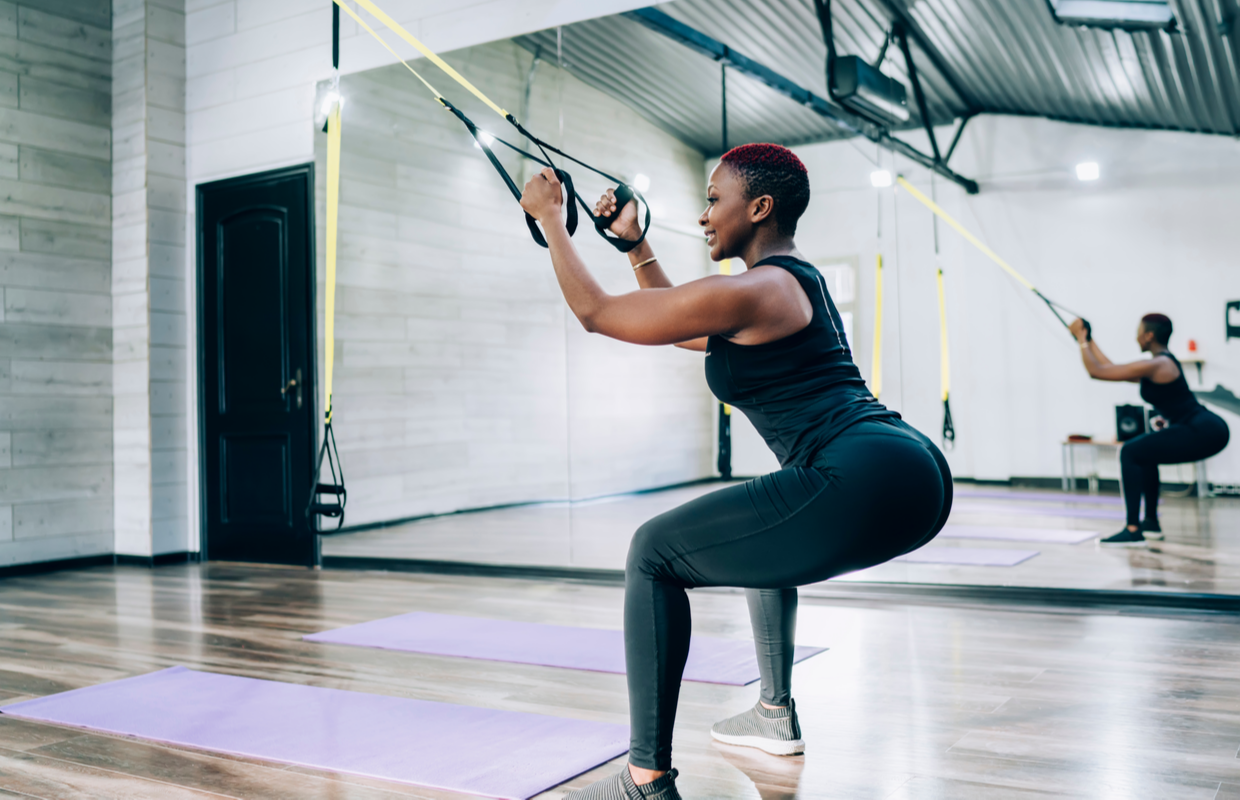From boosting your mood to bolstering your body, strength training has a lot to offer. Kickstart your journey today with our strength training guide for beginners…
If you’re considering adding resistance training to your workout schedule, you should. Whether using your own bodyweight, machines or free weights, strength training boasts benefits for beginners, beyond its ability to sculpt and tone the body.
There’s evidence that supports its role in reducing symptoms of anxiety and depression, plus lifting weights has been shown to improve sleep quality, boost bone health, protect against certain diseases such as heart disease and diabetes, and bolster self-esteem.
Further data presented at the European Society of Cardiology even suggests that people with more muscle power (which is a combination of speed and weight lifting) might live longer. But how often should you work your muscles and what do beginners need to know to get started with strength training?

How often should I do strength training?
The current guidelines from the NHS are that we should be doing strength sessions that work all of the major muscle groups (the legs, hips, back, abdominals, chest, shoulders and arms) at least twice a week, as well as 150 minutes of aerobic activity. But while there’s no doubt that strength training is becoming more and more popular with women, evidence suggests that many of us are still not meeting weekly activity guidelines.
With countless exercises to choose from, numerous pieces of kit available, and good form being paramount, it can certainly be tricky for beginners to get started with strength training. Signing up for a gym induction is a sensible first step – all good gyms will provide members with the chance to learn how to safely use essential equipment from a qualified fitness instructor.
Not a member of a gym? Then it helps to know the basics. This beginner’s guide from Fiona Hawker, a personal trainer with a BSc in Sport & Health Science and business development manager at Curves Gym, reveals everything beginners need to know about getting started with strength training.
Strength training guide for beginners
1. Learn the basics
If you’re unsure of where to start, hire a personal trainer for your first session or choose a good quality at-home workout. For example, Curves offers an at-home workout that focuses on bodyweight strength training plus cardio with variations for all fitness levels, including complete beginners.
If you’re working out without a coach, watch yourself in the mirror to check you’re moving correctly. If you’re working out with a coach, pay attention to their instructions as they will demonstrate and explain the key points to make the exercises safe and more effective.
2. Warm up before strength training
Maintaining good form when you strength train is essential for avoiding injury and ensuring you get the maximum benefits from your workout. Warming up will improve your body’s ability to exercise optimally, as it boosts blood flow around the body, plus increases mobility and muscle activation.
Spend about three-to-five minutes doing aerobic activity to elevate your heart rate, increase blood flow and body temperature. Always warm up, cool down and stretch to reduce the risk of injury.

3. Start with body weight
One of the best strength training tips for beginners is to start with familiar exercises, and bodyweight training is ideal. Most bodyweight exercises are compound moves – they use multiple muscles groups at the same time – so you can build up strength while reducing the risk of injury, until you are strong enough to be able to isolate specific muscle groups.
Squats and press-ups are great examples of compound bodyweight exercises that you might already use in everyday life. They are also easy to add variety to and increase the level of difficulty as your strength improves.
You will need to do a little research to know what muscles you should be working for each exercise – doing this is helpful because it will inform you as to whether you are doing the exercise correctly and ensure you are getting a balanced workout.
You need to be choosing exercises that target all of the major muscle groups (lower body, chest, shoulders, biceps, triceps, back, abdominals) in a balanced way. For example, if you are doing biceps exercises, you also need to include exercises for the triceps to avoid any imbalance in your workout.
4. Weights or machines?
Whether you choose to join a gym or work out from home will likely dictate what type of weight training you do, but for anyone new to exercise, it is important to do the exercises safely. Machines can be a little daunting for beginners, but the benefit of using a machine is that you’re supported and less likely to slip into poor form.
What you are looking to achieve from strength training will also play a large part in what equipment you need. If you want to build a lot of muscle, you will need more weight and more equipment.
However, if you are a beginner who is looking for basic strength training for improved strength, increased lean muscle mass and better body composition, then you have the choice of bodyweight, dumbbells, barbells, kettlebells, resistance machines or resistance bands.
5. Fix your form
Focus on your posture when exercising. Depending on the exercise, stand with your feet about hip-to-shoulder width apart and keep a slight bend in your knees. Keep your back upright, stand tall and keep your head in a neutral position. Engage your core – keeping your core tight throughout each exercise will help to keep you in a good position and allow you to focus on working the intended muscle groups.

6. Reps, sets and weights
When starting out with strength training for beginners, get familiar with reps (or repetitions) and sets. Reps refers to the number of times you perform a single exercise, while sets are the number of times you’ll perform the number of reps. Start with about eight-to-12 repetitions and between one-to-three sets of each exercise.
If you are using weights, start light and gradually increase the weight so that you are challenged by each set but not overtaxed. Keep it simple with a good selection of compound exercises rather than trying to do every exercise. Focus more on doing the exercise well rather than using a lot of weight or a lot of repetitions.
Finally, be consistent by doing your strength training routine at least two-to-three times per week, and don’t forget to include cardio exercises, too.
Words: Sarah Sellens and Fiona Hawker | Images: Shutterstock







